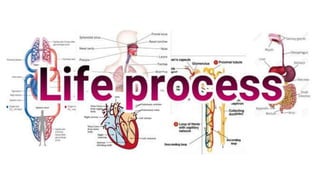Report
Share

Recommended
Recommended
More Related Content
Similar to life process 1.pptx
Similar to life process 1.pptx (20)
Digestive system.pptx////////////////////////////////////////////////////////...

Digestive system.pptx////////////////////////////////////////////////////////...
Recently uploaded
Recently uploaded (20)
Gliese 12 b, a temperate Earth-sized planet at 12 parsecs discovered with TES...

Gliese 12 b, a temperate Earth-sized planet at 12 parsecs discovered with TES...
Film Coated Tablet and Film Coating raw materials.pdf

Film Coated Tablet and Film Coating raw materials.pdf
Alternative method of dissolution in-vitro in-vivo correlation and dissolutio...

Alternative method of dissolution in-vitro in-vivo correlation and dissolutio...
Jet reorientation in central galaxies of clusters and groups: insights from V...

Jet reorientation in central galaxies of clusters and groups: insights from V...
NuGOweek 2024 full programme - hosted by Ghent University

NuGOweek 2024 full programme - hosted by Ghent University
Constraints on Neutrino Natal Kicks from Black-Hole Binary VFTS 243

Constraints on Neutrino Natal Kicks from Black-Hole Binary VFTS 243
GBSN - Microbiology Lab (Microbiology Lab Safety Procedures)

GBSN - Microbiology Lab (Microbiology Lab Safety Procedures)
ERTHROPOIESIS: Dr. E. Muralinath & R. Gnana Lahari

ERTHROPOIESIS: Dr. E. Muralinath & R. Gnana Lahari
The importance of continents, oceans and plate tectonics for the evolution of...

The importance of continents, oceans and plate tectonics for the evolution of...
Climate extremes likely to drive land mammal extinction during next supercont...

Climate extremes likely to drive land mammal extinction during next supercont...
GBSN - Biochemistry (Unit 4) Chemistry of Carbohydrates

GBSN - Biochemistry (Unit 4) Chemistry of Carbohydrates
GBSN - Microbiology (Unit 7) Microbiology in Everyday Life

GBSN - Microbiology (Unit 7) Microbiology in Everyday Life
life process 1.pptx
- 2. Life Process • Life processes are the basic processes in living organisms which are necessary for maintaining their life.
- 3. Which are these life processes • Nutrition • Respiration • Transportation • Excretion
- 4. Nutrition :- Nutrition is the process of taking food by an organism and its utilization by the body to build the body, for growth, to repair the damaged parts of the body and for providing us with the energy.
- 5. Nutrition in Human beings • Nutrition in human beings takes place in the digestive system. • The main organs of the digestive system are mouth, oesophagus, stomach, small intestine, large intestine, and anus. • The main glands are salivary glands, gastric glands, liver, pancreas and intestinal glands.
- 6. • MOUTH – • breaking down of food by teeth • Converts starch into sugar by salivary amylase • OESOPHAGUS – • Peristaltic movement
- 7. STOMACH • Gastric glands • Gastric juice • Enzyme pepsin – breaks protein • Hydrochloric acid – creates acidic medium to facilitate the action of enzyme pepsin. • Mucus – protects the walls of the stomach from the action of the acid.
- 8. SMALL INTESTINE Pancreatic juice Trypsin –breaks protein Lipase- breaks fat Bile juice Breaks fat into small globules • Enzymes present in intestinal juice converts : • carbohydrates into glucose • fats into fatty acids and glycerol • proteins into amino acids
- 9. • Villi • finger like projections • increases the surface area for the absorption of digested food. • LARGE INTESTINE • water is absorbed and the waste material is removed through the anus.
- 10. Respiration
- 11. • Respiration is the process by which food is burnt in the cells of the body with the help of oxygen to release energy. It takes place in the mitochondria of the cells. • The energy released during respiration is used to make ATP molecules (Adenosine tri phosphate) from ADP molecules (Adenosine di phosphate) and inorganic phosphate. Energy • ADP + Phosphate ATP from respiration • Energy is stored in the cells in the form of ATP molecules. When the cells need energy, ATP is broken down in the presence of water to form ADP and energy is released. water • ATP ADP + Energy
- 12. • The main organs of the respiratory system are nostrils, nasal cavity, pharynx, larynx, trachea, bronchi, bronchioles, lungs and diaphragm.
- 13. • Nostrils/Nasal cavity • Pharynx • Larynx • Trachea • Rings of cartilage • Bronchi – bronchioles • Alveoli -increases the surface area for the exchange of gases
- 14. Mechanism of breathing :- • When we breathe in air, the muscles of the diaphragm contracts and moves downward and the chest cavity expands and air enters into the lungs. • When we breathe out air, the muscles of the diaphragm relaxes and moves upward and the chest cavity contracts and air goes out of the lungs.
- 20. THANK YOU